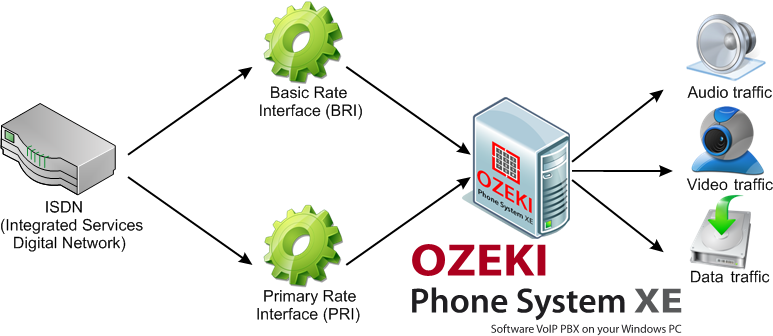ISDN BRI vs. PRI
In the following article you can read about ISDN BRI (Basic Rate Interface) and ISDN PRI (Primary Rate Interface) that are both different types of ISDN lines that are used for transmitting digital data and multimedia data. In the sections of this article you will get to know the basic concept of ISDN and after that there is brief introduction to how they are constructed and where they are usually applied. If you are interested in ISDN telephone lines, it is worth reading the page and watch the video.
The ISDN BRI and ISDN PRI are ISDN line types. ISDN (Integrated Services Digital Network) is a communication standard that is used for delivering digitalized data, video and fax etc. data with voice signals. The data are delivered through a PSTN (Public Switched Telephone Network) network (Figure 1).

Advantages of ISDN
- good sound quality because the ISDN line is digital
- an ISDN line can carry multimedia data (videos, calls, faxes) on the same phone line
- it is a circuit-switched network (there is no data loss)
- ISDN call-establishment and termination is much more faster than analog circuits
About BRI and PRI in General
Both BRI and PRI are ISDN telephone lines (communication standards) that makes ordinary telephone lines be able to deliver audio, video and data traffic. Both telephone line contains channels (bearer channels) that play an important role in data transmission.
The Construction of BRI and PRI
ISDN BRI configuration consists of two, so-called bearer channels: B and D channels. BRI has 2 B-channels and one D-channel. B-channels are 64 Kbit/s voice channels that are responsible for both voice and user data. D-channel is a 16 Kbit/s channel and it is responsible for controlling and signaling different combination of data.
ISDN PRI configuration consists of many channels, depending on the country. In the United States PRI contains 23 B-channels and 1 D-channel and in contrast with with the US, PRI has 30 B-channels and 1 D-channel in Europe. In ISDN PRI line all the channels are 64 Kbit/s channels that are for transmitting data.
Where to Use
ISDN BRI is ideal for homes and small businesses since the BRI line has the capacity of 128 Kbit/s and it is able to handle two calls at the same time on one line.
ISDN PRI is suitable for bigger companies and businesses since it has a bigger capacity: it is able to handle (receive and send) even 30 channels (calls).
Ozeki Phone System supports ISDN phone lines. You need to have an ISDN adapter to be able to connect an ISDN device and also an analog phone to a VoIP service. After the connection, you can make VoIP calls with the ISDN devices and analog phones.
To know these ISDN lines better, take a look at the following pages:
